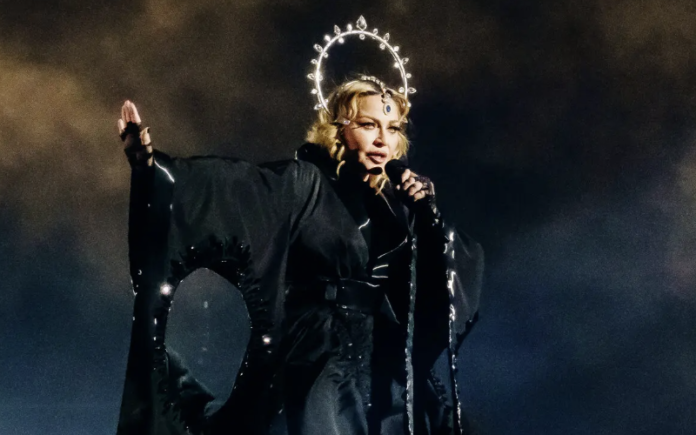Its Celebration Tour is the first retrospective of pop-superstress, which thematically explores its past and perhaps gives an idea of how it will build its future.
For 40 years, evolution, rebellion and stability have been distinguished by Madonna's hallmarks, but its vitality is moving forward. She was the main shark of pop music, which works in almost eternal motion: why should she stop to warm up or look around, risking losing oxygen?
Therefore, the notes of disobedience and unwillingness that are felt in Celebration Tour, her first roud show, dedicated to hits, not a new album, are clear. The retrospective began its North American stage at Barclays Center in Brooklyn on Wednesday night with all the classic attributes of the Madonna show. But unlike her 11 previous tours of this scale, this tour was pursued by ghosts - some of them were invited, and some spoiled the party.
The set list began from the moment of birth-not the beginning of Madonna's career, but the appearance of her firstborn-the song "Nothing Really Matters" from her 1998 album "Ray of Light" about how paternity changes priorities. Anachronism is a table setting: if Celebration tells the story of her life, then her arc is the experience of losing her mother and her own experience of loneliness. "Never forget where you came from," she instructed a dancer who served as an avatar of her young "I", and who then embraced.
The first part of the concert, divided into seven sections, was the most carefree ("everybody", "Holiday", "Open Your Heart"). But joy was built on the fight. Before Madonna came on stage, the leader of the evening, the transvestite Bob reminded the crowd that the singer came to New York with Detroit with 35 dollars in her pocket and scattered counterfeit bills.
Turquoise corset, black mini-skirt and jacket decorated with chains, 65-year-old Madonna radiated the energy of the scene in the center of the late 1970s, where she first found like-minded people and creative inspirations. It was a relief-to return, she said with a f-bomb flight when she took an electric guitar to perform a heavy version of I Love New York, combined with Burning Up, saturated with powerful chords. On the screen behind her were the old photos of CBGB, where she played one of her first concerts.
Soon Glee was hardened by devastation: the community of artists who gave Madonna Shelter was destroyed by AIDS, and she presented Live to Tell as a powerful tribute to memory. On the screens suspended around the scene, which stretched almost the entire length of the floor on a series of catwalks, first showed single faces. The images were then multiplied by demonstrating the scale of the epidemic. It was just too many stories to tell them.
Within two hours, Madonna resisted the simplest way to depict her own story. After the first separation, the concert had only a weak chronological sequence, instead leaning on the topics: her bold sexuality ("erotica", put in the boxing ring, and "Justify My Love", put as almost an orgy); her search for love (obscene "Hung Up" and beloved by "Bad Girl" fans); Her severe disobedience (long -term hit on cowboy "Don't Tell Me"). She seasoned the show with references to previous tours and videos, but missed the obvious choice ("PAPA DON'T PREach", "Express Yourself") in favor of the gap theme about the agent 007 "Die Another Day" and a sharp acoustic caverviv "I willnar" I will.
The most effective number of the show was the song "Like A Prayer", which she sang on a spinning carousel, holding dancers without shirts in impressive poses that mimic the crucifixion of Christ. The propelled bass of Remix created tension, and the quick transition to the song Sam Smith and Kim Petras "Unholy" emphasized the unchanging influence of the original track.
Madonna always focused on what was next, but the artists who followed her chose other ways. Only this year, two women who were younger than her decades, turned into big business yesterday: Taylor Swift delved on stage into her previous album cycles, and Beyonsee played stadium shows inspired by dance music styles that appeared before her birth.
Madonna has never resorted to nostalgia before, and this concert was clear why. In the 1980s, she turned the idea of what he could reach the pop career. In the 1990s, she checked how frankly she could express her wishes. In the 2000s, she found new freedom on the dance floor. In 2010, she launched new voices in her own orbit. But in the past, it is impossible to ignore the flow of time. Now the lesson stretched out the future, and it is unclear how she will count with him.
Until recently, her innovative career was a demonstration seemingly impossible physical strength. But at the end of the theatrical shows of 2020 in support of her last studio album "Madame X" serious injuries made themselves known. The once inexhaustible organism of Madonna brought it a few days before the start of the Celebration Tour tour for July, and she got to the hospital with infection.
In Barclays, she allowed her dancers to do most of her hard work, although she still managed choreography - mostly in heels - for most of the show. Sometimes, jumping on the podium with light hair, she looked like a carefree clutch that turned the world of pop music from the head. Other times, with the hair that lagged behind the rhythm, it looked like a veteran of a scene, who withstood a decades of hard labor.
"I did not think that I was living up to this summer, but here I am here," she said the crowd at the beginning of the speech. She retained a place in the show for those who did not do it: in interesting tribute to Michael Jackson, the silhouette of two super -star -dancing together was designed under the mix "Billie Jean" and "Like A Virgin". Someone, dressed as Prince, imitated solo on one of his branded guitar at the end of Like A Prayer. And, very touching, Madonna honored her son David's biological mother next to her when he joined her while performing Mother and Father.
David broke out on a guitar under this melancholy song from "American Life" as well as "La Isla Bonita"; Her daughter Mercy accomplished her on the piano while performing Bad Girl. But in another Madonna abandoned the band for this tour, instead using the tracks edited by its ancient co -author Stuart Price. This choice deprived the theatrical show and created additional pressure on the vocal of Madonna, which was initially hoarse and sometimes intense. (It is worth noting that the crowd also did not accept the high notes of "Crazy for you").
Madonna, long known as a perfectionist, seemed more relaxed and talkative throughout the evening. Several pauses to the public were arranged throughout the set, and she was delighted during a playful tribute to the ball stage, which she covered in Vogue, where her 11-year-old daughter Estre had on the catwalk. For Ray of Light, Madonna looked as if she had fun to dance in a rectangular elevator that lifted her above the crowd.
Madonna has known the power of video for a long time, and the most effective embodiment of its influence was the installation in front of the penultimate number of the show, which seized the headlines of newspapers and the news about its unprecedented ability to shock the world. "The most controversial thing I have ever done is to stay here," she said in her speech in 2016, emphasizing that she constantly had to fight double-scourge-sexism and age discrimination.
New York residents, she noted from the stage, do not like when they indicate what to do. But, perhaps, finally stopping and looking back, she saw a different way forward: her deserved era of heritage. "Something ends," she sang in the song "Nothing Really Matters", switching on stage alone, "and something begins."


